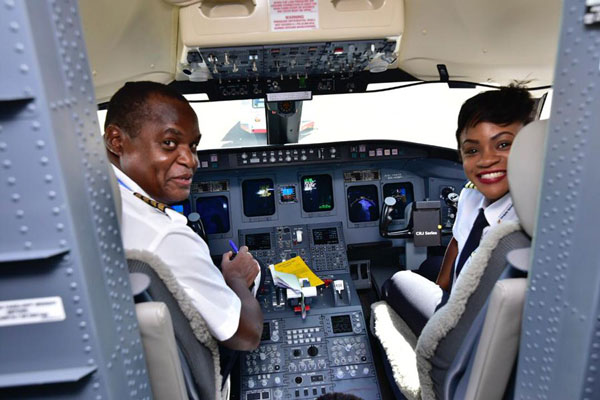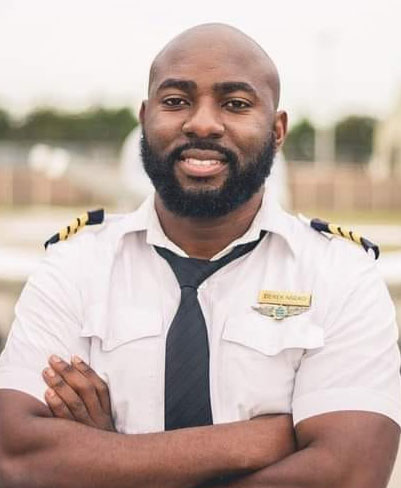
Becoming an airline pilot is not an easy task, but with hard work and dedication, it is achievable.
SPECIAL FEATURE | DEREK NSEKO | The role of a pilot is one of the most exciting and rewarding careers in the aviation industry. Pilots are responsible for the safe and efficient operation of aircraft, from takeoff to landing. They are the ultimate authority on board and are responsible for the lives of their passengers and crew.
Becoming a commercial pilot is a challenging but achievable goal for those who are passionate about flying. The first step in becoming a commercial pilot is to obtain a private pilot license (PPL). This license allows you to fly solo or with passengers, but only for recreational or personal use.
Once you have your PPL, you can begin training for a commercial pilot license (CPL). This license allows you to fly for hire or reward, meaning you can fly for an airline, charter company, or other commercial operation. Training for a CPL typically includes flight training, ground school, and flight simulation.
Flight training involves both solo and dual flight time. Solo flight time allows you to practice and hone your skills while dual flight time is spent with an instructor who will evaluate your performance and provide feedback. Ground school is a classroom-based course that covers aerodynamics, navigation, weather, and other topics that are essential for safe flight operations. Flight simulation allows you to experience different flight scenarios and conditions in a controlled environment.
Once you have completed your training, you will need to pass a rigorous written and practical exam to obtain your CPL. This exam includes a flight test, an oral exam, and a medical examination. After passing the exam, you will be issued a commercial pilot license and will be qualified to fly as a first officer for an airline or other commercial operation.
The path to becoming a commercial pilot is long and challenging, but the rewards are well worth it. As a commercial pilot, you will have the opportunity to see the world, meet new people, and experience the thrill of flying. If you are passionate about flying and have the drive and determination to succeed, then a career as a commercial pilot may be the perfect fit for you.
Before joining a flight school, here is how one can prepare for the world of aviation:
- Read and Study: Start reading and studying about aviation, aerodynamics, navigation, weather, and other topics related to flying. Familiarizing yourself with the basics will make your flight training easier and more efficient.
- Get Medical Clearance: Before joining flight school, you will need to obtain a medical clearance from an Aviation Medical Examiner (AME). This will ensure that you meet the physical and medical requirements for flying.
- Take a Trial Flight: Before joining flight school, take a trial flight to experience what it’s like to fly. This will give you an idea of whether you’re comfortable and if you have any fears or concerns that need to be addressed. A trial or intro flight can be done at any flight training school in the country.
- Start Saving: Flight training can be expensive, so start saving as early as possible. This will help you pay for your flight training and any additional expenses.
- Network: Building relationships with other pilots and instructors can open doors to job opportunities and provide you with valuable advice and insights.
- Stay motivated: It’s a long journey, and it requires a lot of dedication, hard work, and patience. Stay motivated and focused on your goal. This is crucial.
Practical Steps:
- Choose a Flight School.
When choosing a flight school, there are several criteria to consider in order to ensure that you receive the best training possible. These include:
- Accreditation: Make sure the flight school is accredited by the appropriate aviation authorities, Uganda’s aviation sector is regulated by the Uganda Civil Aviation Authority. Accreditation ensures that the school meets certain standards for quality and safety.There are currently 9 approved Aviation Training Organizations (ATOs) in the country: Vine Air, Kubis Aviation College, Kajjansi Flying School, Moriah Aviation Training Centre, DAS Aviation School, Uganda Aviation Academy, East African Civil Aviation Academy, Aero Consultants and Ocean Heights Aviation Training Centre. While these are all approved, not all will offer pilot Training.
- Location: Consider the location of the flight school. Is it close to where you live or will you have to relocate? Are the weather conditions in the area suitable for flight training? Typically, rain, strong winds and low cloud are not good conditions for flight training.
- Fleet: Check the fleet of the flight school. Do they have the type of aircraft you want to train on? Any decent school will have a website and will list it’s aircraft fleet for you. Alternatively, call or visit the school and discuss this with an instructor.
- Safety Record: Check the safety record of the flight school. Are the aircraft well-maintained and in good condition? Do they have a good track record of safety? Are there any incidents or accidents that have occurred at the school in the past? If you are not confident getting this information from the actual school, you can contact the aviation regulator,the Uganda Civil Aviation Authority.
- Instructor-to-Student Ratio: Consider the instructor-to-student ratio. The lower the ratio, the more individualized instruction you will receive.
- Training Curriculum: Check the flight school’s training curriculum. Does it meet your needs? Does it include the type of training you are looking for? Different schools will package their training curriculum differently. This could also affect the overall cost.
- Cost: Consider the cost of the flight school. Are the costs reasonable? Are there any hidden fees?
- Reputation: Check the reputation of the flight school. Do they have a good reputation in the industry? Are they known for producing quality pilots? This can only be found out by seeking out and speaking to other industry professionals.
- Graduation and Job placement rate: Look at the flight school’s graduation and job placement rate. A school with a high rate of graduates who are able to find jobs in the industry is a good indication of the quality of their training.
- Additional features: Some flight schools offer additional features such as accommodation, transportation, and access to simulation equipment. Consider whether these features are important to you and whether the school offers them.
2. Obtain a Private Pilot License (PPL): The first step in becoming an airline pilot is to obtain a private pilot license (PPL). This license allows you to fly solo or with passengers, but only for recreational or personal use. To obtain a PPL, you will need to pass a written exam, a medical exam, and a flight test.
3. Gain Flight Experience: After obtaining your PPL, it is important to gain as much flight experience as possible. This includes solo and dual flight time, as well as cross-country and night flights. Building up your flight hours is critical to your future as an airline pilot. Flight schools will package hour building into your commercial pilot training.
4. Complete Ground School: Ground school is a classroom-based course that covers aerodynamics, navigation, weather, and other topics that are essential for safe flight operations. You will need to complete ground school before proceeding to the next step.
5. Complete an Airline Transport Pilot (ATP) course: To become an airline pilot, you will need to complete an Airline Transport Pilot (ATP) course. This training program is designed to provide you with the knowledge and skills required to fly as a commercial pilot for an airline.
6. Get a Job: Once you pass the exams, you will be qualified to apply for jobs as an airline pilot. Start applying for jobs with airlines, charter companies, and other commercial operations.
Continual training and check-ups: Once you land a job as an airline pilot, you will need to continue your training and education to maintain your license and stay current with new regulations and procedures.
Advice:
- Networking is key. Building a relationship with other pilots and instructors can open doors to job opportunities.Unfortunately, commercial pilots are not walking around in their uniforms at your local mall or hangout spot. You will have to visit schools, aviation companies or be digitally creative to find industry people. Facebook groups and communities offer a quick option. For example the African aviation group on Facebook is the largest online community of aviators and enthusiasts in the world with over 350,000 members.
- Consider working for a flight school as an instructor, a charter company, domestic or regional airline as a first officer, which will provide you with the experience you need to advance in your career. This will also give you experience with different types of aircraft and different flight conditions and make sure you meet the minimum qualifications and requirements for an airline pilot, including the required flight hours and education.
- Stay physically and mentally fit. Piloting an aircraft is a demanding job, so it’s important to maintain a healthy lifestyle.
Becoming an airline pilot is not an easy task, but with hard work and dedication, it is achievable. Building up your flight hours and gaining the required education and experience are critical to your success as an airline pilot. Networking, gaining experience with different types of aircraft, and staying fit, both physically and mentally, will also help you achieve your goal of becoming an airline pilot.
********
 The writer, Derek Nseko is an aviation consultant, a qualified commercial pilot, Founder and CEO at Airspace Africa and iFly Global. derek@airspace-africa.com twitter: @av8r_derek
The writer, Derek Nseko is an aviation consultant, a qualified commercial pilot, Founder and CEO at Airspace Africa and iFly Global. derek@airspace-africa.com twitter: @av8r_derek
 The Independent Uganda: You get the Truth we Pay the Price
The Independent Uganda: You get the Truth we Pay the Price




how can i get in contact with a pilot
can i become a pilot minus the study of a level